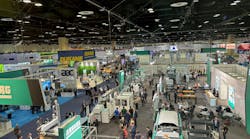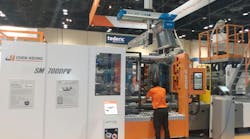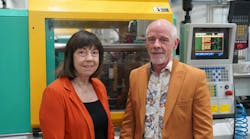A few years ago, I visited an injection molding plant that had recently become a Tier 2 automotive supplier and was looking for more automotive business. Placed just inside the door was a molding machine equipped with a robot, the only robot in the plant.
“This robot made us an automotive supplier,” the owner said. “We put it right up front so it is the first thing a customer sees. It makes us look modern.”
Today that robot probably does more than just boost the company’s image.
Robots are the unsung heroes of manufacturing’s challenging era of COVID-19, supply chain disruptions and severe labor shortages.
We have passed the point where plastics processors are trying to decide if they need robots. Nowadays, the questions are “what type of robot or cobot do I need?” and “how many robots can I afford?”
At a more recent plant visit — also to an automotive supplier where a majority of the molded parts required secondary operations such as assembly — the processor was building an assembly operation that needed two robots, one to take a part out of the molding machine and move it to the assembly fixture so another robot could complete the assembly and pack the part for shipment — no hands required.
Actually, there was a lot of hands-on work required to engineer the process, build assembly fixtures and apparatus and align the robots to work together. But the investment of human time and brain power was well spent. The investment in one robot and one cobot seemed inconsequential.
Welcome to modern manufacturing, where robots are changing job profiles of factory workers for the better.
The International Federation of Robotics recently listed five trends in robots for 2022.
Robots will be adopted by new industries such as retail and restaurants, construction and agriculture.
Robots will become easier to use with user interfaces based on simple icon-driven programming.
The need will continue to grow for basic robot and automation education at a younger age. Robot manufacturers already have as many as 30,000 participants a year in their robot classes.
Automation makes reshoring and nearshoring possible. A manufacturing operation that was moved to Asia to take advantage of cheaper labor can move back to the U.S. and be cost-competitive when extensive automation drives the process. Parts being manufactured closer to where they are needed helps eliminate supply-chain problems.
Modern manufacturing is depending more and more on data. Artificial intelligence (AI) is becoming mainstream and robots that collect data will, in turn, be able to use information to improve the operation.
Jeff Burnstein, president of the Association for Advancing Automation (A3), told PMM Senior Staff Reporter Karen Hanna about a project underway to use four robots to change automobile tires. I have seen welding cells that use two robots, automobile waxing demonstrations with three robots and an assembly cell that employs six robots.
Cost is no longer a major stumbling block even for small companies. Joe Campbell, senior manager for strategic marketing and application development at cobot manufacturer Universal Robots, told PMM Senior Staff Reporter Bruce Geiselman that it is now common to see complete systems for machine tending, welding and palletizing deployed for less than $100,000 and often less than $85,000.
That may be the next frontier for plastics processors. There is significant value in using robots to place inserts into molds and take parts out of molds, but perhaps we need to think a little farther outside of the box.
Combining robots with sophisticated vision systems and AI makes it possible for the robot to identify and orient parts coming out of the molding machine, then weld, insert seals and screws, install caps, test and record functionality of the completed component, pack and finally palletize it for shipment.
Stand at the front of your plant and think about how you could operate with 30 percent fewer people, or better yet, think about how you could double production with the same number of people and processing machines.
Viking Plastics in Corry, Pa., has doubled production with the same number of molding machines through lean manufacturing. Read the story on Page 16. Intelligent use of automation and robots is a cornerstone of its process.
The Biden administration wants to spend significant amounts of money to modernize manufacturing in the U.S. This may be the impetus needed for big advancements in plant automation. I have written before that we may look back at this moment in history as a significant period of change, and I believe it more every day.
It is an exciting time for manufacturing. How do you take advantage of the change? Be open to innovation, be smart about smart technology and plan strategically for how your plant will run in the future.
Ron Shinn, editor






